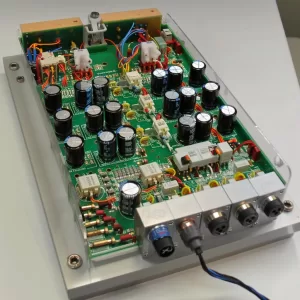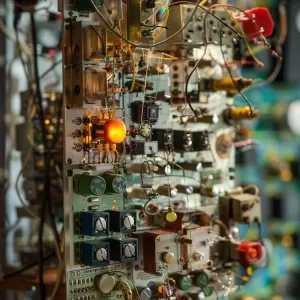
Solid State Relays vs Electromechanical Relays: A Comprehensive Comparison
March 27 2024 
Inquiry
Global electronic component supplier AMPHEO PTY LTD: Rich inventory for one-stop shopping. Inquire easily, and receive fast, customized solutions and quotes.
QUICK RFQ
ADD TO RFQ LIST
In this blog, we will delve into a comprehensive comparison of Solid State Relays and Electromechanical Relays, exploring their functionalities, advantages, and ideal applications.
What are Solid State Relays?

What are Solid State Relays Used for?
- Gate Drivers for Power Electronics: These devices separate control signals from high-power switching circuits in applications such as motor drives and solar inverters. This safeguards the control circuitry against voltage spikes and transient currents.
- Audio Equipment: SSRs can be used to remove ground loops from audio equipment, increasing sound quality by decreasing unwanted hum and noise. Their rapid switching speeds minimize signal distortion.
- Measurement and Instrumentation: They isolate measurement instruments from the circuits under test, resulting in accurate and trustworthy measurements. This is critical for protecting sensitive instruments from high voltages and transients.
What are Electromechanical Relays?

Why are Electromechanical Relays Used?
- General Purpose Switching: Due to its simple design and low cost, EMRs are widely employed in a variety of switching applications. Controlling lights, motors, and solenoid valves are a few examples.
- Low-Power Applications: EMRs can be an appropriate and cost-effective solution for applications requiring low currents.
- High Surge Currents: EMRs can withstand higher initial surge currents than some SSRs.
- Interface with Low-Level Control Signals: Certain EMRs are designed to work with low-level control signals, making them ideal for integration with microcontroller systems.
How do Solid State Relays Work?
The inner workings of an SSR involve a combination of semiconductors. Here's a simplified breakdown:- Input (Control) Circuit: This circuit receives a low-voltage control signal, usually a DC voltage, which causes the switching action.
- Isolation Barrier: Some SSRs have an isolation barrier (transformer or optocoupler) between the control and load circuits to reduce electrical leakage and improve safety.
- Output (Load) Circuit: This circuit handles greater voltages and currents that must be turned on or off. The control signal activates the semiconductors in the SSR, which regulates the flow of power to the load.
How to Wire a Solid State Relay?
Connecting an SSR involves proper wiring of the control and load circuits. Here are some general steps:- Identify Terminals: Refer to the SSR's datasheet to identify the terminals for the control circuit (input) and the load circuit (output). These are often identified with unambiguous indicators such as "Control +" and "Control -", or "Load +" and "Load -".
- Control Circuit Wiring: Connect the control voltage source (DC in most SSRs) to the SSR's specified control terminals. Make sure the polarity is right (positive to positive, negative to negative). The datasheet will specify the control voltage level required to trigger the SSR.
- Load Circuit Wiring: Connect the load (the device or circuit that you want to control) to the SSR's designated load terminals. These terminals are often designed to manage the load circuit's greater AC or DC voltage and current. Ensure that the SSR's current rating is adequate for your application.
- Heat Sink Considerations: Many SSRs, particularly those that handle large currents, produce heat during operation. The datasheet will indicate whether a heat sink is required for proper cooling. To achieve safe operating temperatures, put the SSR on a suitable heat sink and use adequate thermal paste.
- Safety Precautions: Safety precautions include double-checking all connections before providing electricity. When working with live circuits, always follow proper electrical safety precautions. Turn on the power with caution and monitor the SSR's performance to verify the correct switching functionality.
How do Electromechanical Relays Work?
- Apply Control Voltage: You apply voltage to the coil's terminals.
- Current Flow and Magnetism: Electricity passes through the coil's wire, creating a magnetic field surrounding the iron core.
- Magnetic Pull: The magnetic field works as an invisible hand, attracting the armature to the coil.
- Armature Movement: When the magnetic force exceeds the spring tension (or beginning position), the armature moves.
- Contact Switching: The movement of the armature causes the contacts to change places. A normally open (NO) relay's contacts will touch, completing a circuit. A normally closed (NC) relay's contacts will separate, breaking the circuit.
- Maintaining the State (Holding the Connection): Some relays' designs allow the armature to remain in its new position (holding current) long after the initial current through the coil has stopped. The holding current is typically less than the initial current necessary to move the armature.
- Remove Control Voltage: When the voltage to the coil is interrupted, the magic reverses.
- Magnetic Field Dissipates: The magnetic field surrounding the coil diminishes and eventually dissipates.
- Spring Action Takes Over: The spring (always present) returns the armature to its original place.
- Contacts Reset: With the armature back in place, the contacts are restored to their original condition. The contacts of a NO relay detach, causing the circuit to fail. In an NC relay, the contacts re-touch, completing the circuit.
How are Electromechanical Relays Used?
When a voltage is applied to the coil, it powers the electromagnet. The generated magnetic field draws the armature, which moves against the spring tension. Depending on the relay's design, this movement of the armature opens or closes a set of contacts. The change in contact state determines the flow of current in the load circuit.Are Solid State Relays More Reliable?
Solid state relays (SSRs) are generally thought to be more reliable than electromechanical relays (EMRs) in certain applications due to their absence of moving parts and wear-prone components. Here are some reasons why SSRs are frequently considered as more reliable:- No Moving Parts: There are no moving parts in SSRs, which employ semiconductors like transistors and thyristors to switch the load rather than physical connections. The absence of moving parts decreases the possibility of mechanical failure, wear, and contact arcing, all of which are common failure modes in EMRs.
- Faster Switching Speeds: SSRs have substantially faster switching speeds than EMRs since they use electronic switching rather than mechanical movement. This can be useful in situations where rapid switching is necessary.
- Silent Operation: SSRs function quietly since they have no moving parts. This can be useful in applications where noise is an issue or quiet operation is preferred.
- No Contact Bounce: EMRs can experience contact bounce, which is a brief period of fast contact closures and reopening when the relay switches. This may cause problems in sensitive circuits. This is not a concern for SSRs because they switch electronically.
Solid State Relays vs Electromechanical Relays
Here's a table summarizing the key differences:| Feature | Solid State Relay (SSR) | Electromechanical Relay (EMR) |
| Operating Principle | Electronic (Semiconductors) | Mechanical (Electromagnet & Contacts) |
| Lifespan | Longer (fewer moving parts) | Shorter (contact wear) |
| Cost | Generally higher | Generally lower |
| Noise Generation | Silent | Can generate a clicking sound |
| Control Signal Voltage | Typically DC | Can be DC or AC |
| Size | Can be larger for high currents | Can be smaller for the same current rating |
Video related to Solid State Relays vs Electromechanical Relays
How Long do Solid State Relays Last?
The lifespan of an SSR depends on various factors, including:- Operating Conditions: SSRs that are exposed to extreme temperatures, overload, or numerous switching cycles will have a lower lifespan.
- Quality: Higher-quality SSRs from reputable manufacturers typically have longer lifespans.
- Heat Management: Proper heat sinking is required to keep the SSR operating within its recommended temperature range, hence extending its lifespan.
Where are Solid State Relays Used?
- Test and Measurement Equipment: SSRs are utilized in test equipment to switch signals and control power supply due to their quick switching speeds and low noise emission.
- Power Supplies and Battery Backup Systems: In power supplies and battery backup systems, SSRs can be used to control power outputs or to transition between AC and DC power sources.
- Industrial Automation: Because of their quick switching rates and extended lifespans, SSRs are commonly used in industrial control systems to switch motors, valves, and other high-power loads.
- Building Automation: SSRs provide silent and dependable switching for electrical components in HVAC systems, lighting controls, and security systems.
- Medical Equipment: SSRs' precise control and isolation characteristics can help some medical systems, such as infusion pumps and dialysis machines.
Where are Electromechanical Relays Used?
- Appliance Controls: EMRs are commonly used in domestic appliances such as refrigerators, washing machines, and dryers to regulate motors and heating components.
- Automobile Applications: EMRs are used for a variety of automobile applications, including starting motor control, turn signal circuits and headlight relays.
- Security Systems: EMRs are used in security systems to activate alarms, control door locks, and perform other security functions.
- Audio Equipment: Audio equipment contains EMRs for functions such as speaker selection and signal routing.
Conclusion
Solid State Relays (SSRs) and Electromechanical Relays (EMRs) serve important roles in a variety of electrical control applications. Understanding their various functionalities, advantages, and limits is critical for making sound judgments when choosing the best relay for your project. What are Solid State RelaysWhat are Solid State Relays Used forWhat are Electromechanical RelaysWhy are Electromechanical Relays UsedHow do Solid State Relays WorkHow to Wire a Solid State RelayHow do Electromechanical Relays WorkHow are Electromechanical Relays UsedAre Solid State Relays More ReliableSolid State Relays vs Electromechanical RelaysVideo related to Solid State Relays vs Electromechanical RelaysHow Long do Solid State Relays LastWhere are Solid State Relays UsedWhere are Electromechanical Relays UsedConclusion
Populer Posts
